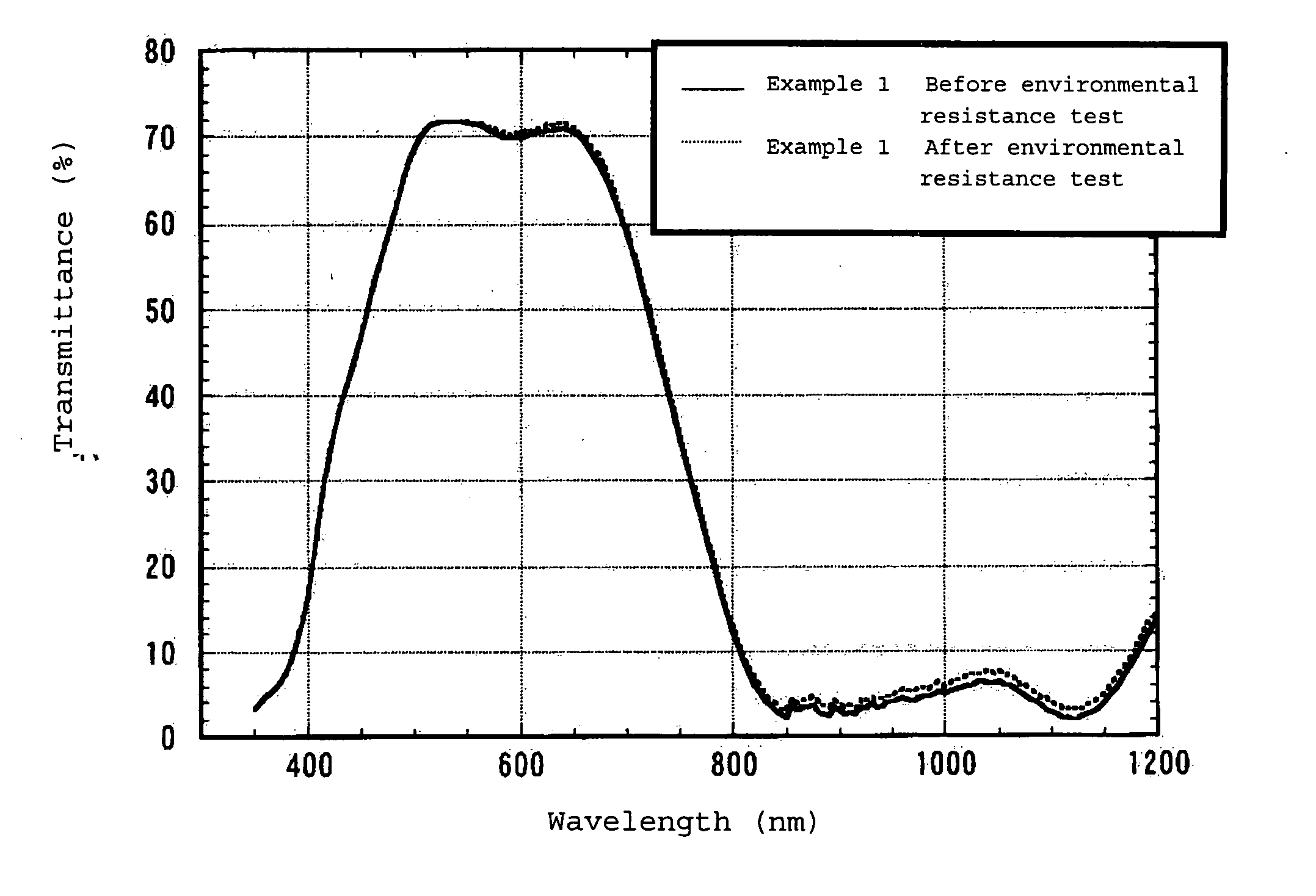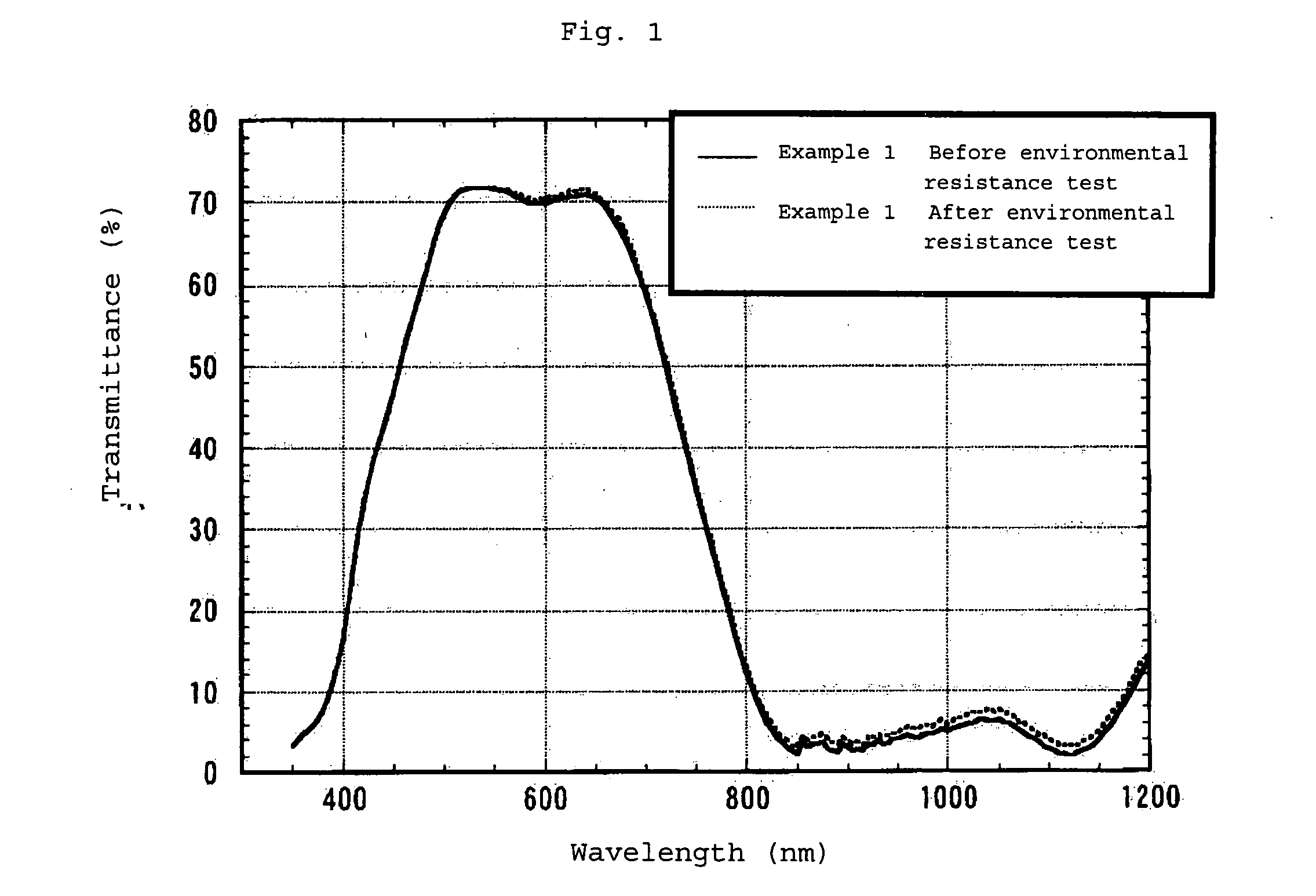Infrared Absorption Filter
- Summary
- Abstract
- Description
- Claims
- Application Information
AI Technical Summary
Benefits of technology
Problems solved by technology
Method used
Image
Examples
synthesis example 1
[0130] 9,810 parts of ion exchange water and 1,930 parts of a 48% aqueous solution of sodium hydroxide were added to a reactor equipped with a thermometer, stirrer and reflux condenser, 1,065 parts of 2,2-bis(4-hydroxyphenyl)propane, 1,177 parts of 9,9-bis(4-hydroxy-3-methylphenyl)fluorene and 4.5 parts of sodium hydrosulfite were dissolved in the resulting solution, 6,610 parts of methylene chloride was added, and 1,000 parts of phosgene was blown into the reactor for 60 minutes under agitation at 16 to 20° C. After phosgene was blown, 50.2 part of p-tert-butylphenol and 317 parts of a 48% aqueous solution of sodium hydroxide were added, and 0.94 part of triethylamine was further added and stirred at 20 to 27° C. for 40 minutes to terminate a reaction. A methylene chloride layer containing the reaction product was washed with diluted hydrochloric acid and pure water, and methylene chloride was evaporated to obtain FLPC. The obtained FLPC contained 40 mol % of a recurring unit havin...
synthesis example 2
[0131] 10,120 parts of ion exchange water and 1,857 parts of a 48% aqueous solution of sodium hydroxide were added to a reactor equipped with a thermometer, stirrer and reflux condenser, 512.8 parts of 2,2-bis(4-hydroxyphenyl)propane, 1,984 parts of 9,9-bis(4-hydroxy-3-methylphenyl)fluorene and 4.3 parts of sodium hydrosulfite were dissolved in the resulting solution, 7,632 parts of methylene chloride was added, and 1,000 parts of phosgene was blown into the reactor for 60 minutes under agitation at 16 to 20° C. After phosgene was blown, 33.7 parts of p-tert-butylphenol and 353 parts of a 48% aqueous solution of sodium hydroxide were added, and 0.95 part of triethylamine was further added and stirred at 20 to 27° C. for 40 minutes to terminate a reaction. A methylene chloride layer containing the reaction product was washed with diluted hydrochloric acid and pure water, and methylene chloride was evaporated to obtain FLPC. The obtained FLPC contained 70 mol % of a recurring unit hav...
synthesis example 3
[0132] 1,000 parts of 9,9-bis[4-(2-hydroxyethoxy)phenyl]fluorene, 503 parts of diphenyl carbonate, 0.10 part of tetramethylammonium hydroxide and 0.0018 part of sodium hydroxide were fed to a reactor equipped with a stirrer, distiller and decompressor, the inside of the reactor was substituted by nitrogen, and these substances were dissolved at 140° C. After 30 minutes of agitation, a reaction was carried out for 30 minutes by gradually increasing the inside temperature to 180° C. and reducing the pressure to 1.33×104 Pa, and the formed phenol was distilled off. The temperature was kept increased by maintaining the same pressure to distill off phenol at 200° C. for 30 minutes, at 220° C. for 30 minutes, at 240° C. for 30 minutes and further at 260° C. for 20 minutes. Subsequently, the pressure was gradually reduced, stirring was carried out at 260° C. and 133 Pa or less for 4 hours, and the product was taken out from the reactor to obtain FLPC. The obtained FLPC was composed of a fl...
PUM
| Property | Measurement | Unit |
|---|---|---|
| Percent by mass | aaaaa | aaaaa |
| Percent by mass | aaaaa | aaaaa |
| Mass | aaaaa | aaaaa |
Abstract
Description
Claims
Application Information
 Login to View More
Login to View More - R&D
- Intellectual Property
- Life Sciences
- Materials
- Tech Scout
- Unparalleled Data Quality
- Higher Quality Content
- 60% Fewer Hallucinations
Browse by: Latest US Patents, China's latest patents, Technical Efficacy Thesaurus, Application Domain, Technology Topic, Popular Technical Reports.
© 2025 PatSnap. All rights reserved.Legal|Privacy policy|Modern Slavery Act Transparency Statement|Sitemap|About US| Contact US: help@patsnap.com



